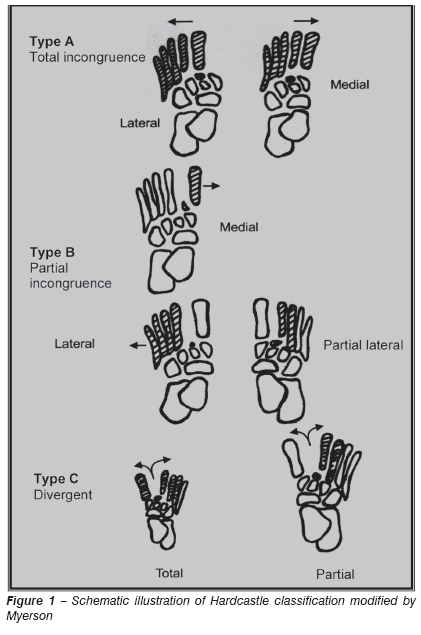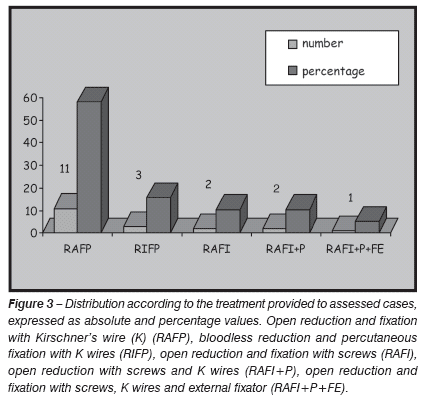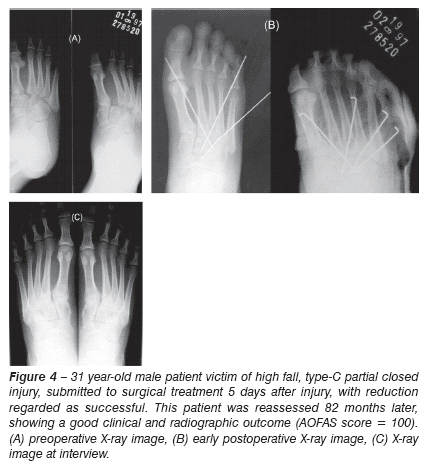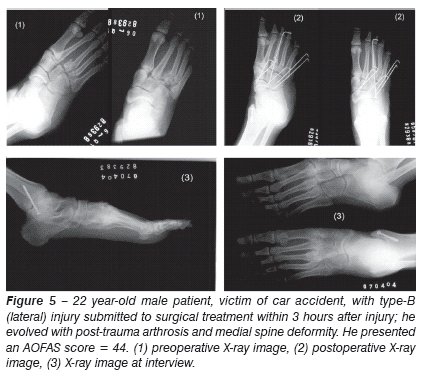Abstracts
This was a retrospective study of 19 cases of Lisfranc fracture-dislocation surgically treated during the period of 1995 - 2003. The follow-up period was 35 months (range: 4 - 97 months). Surgical treatment was provided on the day of the injury in 14 cases, taking an average of 4.78 hours. There were 5 open injuries (36.32%) and 5 patients experienced multiple injuries. The most frequent mechanisms of injury were motorcycle accidents, followed by falls from animals, and high falls. The functional evaluation proposed by AOFAS (The American Orthopaedic Foot and Ankle Society) was employed, which reported an average of 77.53 (ranging from 44 to 100). A correlation was found between the quality of the reduction achieved and treatment outcome (p = 0.0449), and between multiple traumas and poorer AOFAS score results (p = 0.0143). Complications such as osteoarthritis occurred in 8 cases (42.10%), confirming this as the main radiographic complication of these injuries. Its incidence was analyzed comparing the quality of the reduction to the different types of injury (open or closed, ligament injury or fracture, isolated injury or multiple injuries) not reporting any statistically significant correlation (p<0.005).
Bone fractures; Dislocations; Metatarsal bones; Tarsal Joints
Estudo retrospectivo de 19 casos de fratura-luxação de Lisfranc tratados cirurgicamente no período de 1995 a 2003. O tempo de acompanhamento foi de 35 meses (variando de 4 a 97 meses). O tratamento cirúrgico foi realizado no dia do trauma em 14 casos, com média de demora de 4,78 horas. Ocorreram 5 lesões expostas (36,32%) e 5 pacientes foram vítimas de politraumatismo. O mecanismo de lesão mais freqüente foi o acidente motociclístico, seguido da queda de animais e de altura. Utilizou-se a avaliação funcional proposta pela AOFAS (The American Orthopaedic Foot And Ankle Society), que apresentou média de 77,53 (variou de 44 a 100). Houve relação entre a qualidade da redução obtida e o resultado do tratamento (p = 0,0449) e entre o fato do pacientes ser vítima de politraumatismo e um resultado inferior do escore AOFAS (p= 0.0143). Houve como complicação a presença de Osteoartrose em 8 casos (42,10%), confirmando-a como a principal complicação radiográfica destas lesões. Sua ocorrência foi analisada comparando-se com a qualidade da redução e com os diferentes tipos de lesão (exposta,lesão ligamentar ou fratura, se lesão isolada ou politraumatismo) não encontrando relação com significância estatística (p < 0,005).
Fraturas ósseas; Luxações; Ossos do metatarso; Articulações tarsianas
ORIGINAL ARTICLE
Evaluation of the surgical treatment of Lisfranc joint fracture-dislocation
Cléber de Jesus PereiraI; Eduardo Gomes EspinosaII; Ivan MirandaIII; Marcelo Bueno PereiraIV; Roberto Sérgio de Tavares CantoV
IAssistant Doctor, Ankle and Foot Group, Orthopaedics and Traumatology Service of the Federal University of Uberlândia's Hospital das Clínicas
IIAssistant Doctor, Ankle and Foot Group, Orthopaedics and Traumatology Service of the Federal University of Uberlândia's Hospital das Clínicas
IIIPh.D. in Orthopaedics and Traumatology, Head of the Ankle and Foot Group, Orthopaedics and Traumatology Service of the Federal University of Uberlândia's Hospital das Clínicas
IVAssistant Doctor, Ankle and Foot Group, Orthopaedics and Traumatology Service of the Federal University of Uberlândia's Hospital das Clínicas
VPh.D. in Orthopaedics and Traumatology, preceptor of Medical Residency, Federal University of Uberlândia's Hospital das Clínicas
Correspondences to
SUMMARY
This was a retrospective study of 19 cases of Lisfranc fracture-dislocation surgically treated during the period of 1995-2003. The follow-up period was 35 months (range: 4 - 97 months). Surgical treatment was provided on the day of the injury in 14 cases, taking 7.48 hours in average. There were 5 open injuries (36.32%) and 5 patients experienced multiple injuries. The most frequent mechanisms of injury were motorcycle accidents, followed by falls from animals, and high falls. The functional evaluation proposed by AOFAS (The American Orthopaedic Foot and Ankle Society) was employed, which reported an average of 77.53 (ranging from 44 to 100). A correlation was found between the quality of the reduction achieved and treatment outcome (p = 0.0449), and between multiple traumas and poorer AOFAS score results (p = 0.0143). Complications such as osteoarthritis occurred in 8 cases (42.10%), confirming this as the main radiographic complication of these injuries. Its incidence was analyzed comparing the quality of the reduction to the different types of injury (open or closed, ligament injury or fracture, isolated injury or multiple injuries) not reporting any statistically significant correlation (p<0.005).
Keywords: Bone fractures; Dislocations; Metatarsal bones; Tarsal Joints.
INTRODUCTION
Tarsometatarsal joint fracture- dislocation is rare, having an incidence of about 1for each 55,000 people a year, corresponding to 0.2% of all fractures(1-9). It was so named in homage to the French physician Jacques Lisfranc, who described an amputation of that joint. Some authors attribute the reason for its low incidence rate to the absence of a proper diagnosis, particularly in multiple-trauma patients, which can occur in as much as 20% of the cases(5,6,8,10-19).It is regarded as a serious foot condition, potentially leading to acute and chronic complications, such as vascular injury, compartmental syndrome, nervous lesion, skin necrosis, gangrene, arthrosis, pseudoarthrosis, exostosis, chronic pain, among others(5). The mechanism of trauma for these injuries is not well defined, and may occur as a result of direct and indirect trauma(5,8). In vitro studies correlate metatarsal's plantar flexion trauma to torsional stress(20). This injury results from high-energy trauma, with the most frequent causes being: car accidents, motorcycle accidents, and labor-related accidents, which, taken together, account for over half of the cases(12,19). Low-energy injuries can cause ligament rupture as well, particularly in athletes and aged patients(12,19). Plain X-ray images at anteroposterior (AP), lateral and oblique planes are enough to provide a diagnosis. In some situations, conventional X-ray images are not clarifying, sometimes requiring a stress test on the joint under anesthesia to show the injury(14,18). Vouri and Aro reported a series in which 39% of the cases (59 cases), the diagnostic X-ray imaging was not early performed, leading to an inappropriate treatment(10). Fracture of the 2nd metatarsal base and increased 1st intermetatarsal space are indicative of severe injury(18,21). When treating a fracture-dislocation of the tarsometatarsal joint, an early diagnosis associated to a fast anatomical reduction and stable fixation provide excellent results(1,5-7,17-19,22-25).
With the anatomical reduction, 50 - 95% of the patients present satisfactory outcomes, while in patients with non-anatomical reduction, satisfactory outcomes are seen in as few as 17 -30%(5,21,26).
The purpose of this study is to assess the surgical treatment of Lisfranc injuries, according to AOFAS criteria (functional assessment recommended by The American Orthopaedic Foot and Ankle Society), treated in our service from 1995 to 2003, as well as its progression and potential complications.
MATERIALS AND METHODS
This is an observational and retrospective study of patients diagnosed with Lisfranc fracture-dislocation surgically treated in our service during the period of 1995 to 2003. The inclusion criteria were as follows: skeletal maturity, fracture-dislocation or dislocation of the tarsometatarsal joint with no previous injuries on the affected foot and indicated to surgical treatment (joint instability and deviations > 2mm compared to normal X-ray parameters of the foot). Medical files of 30 patients meeting the inclusion criteria were retrieved from the relevant department, which were invited to take part of this study. Of these, 19 came spontaneously and were submitted to a clinical evaluation (orthopaedic examination, update of data relevant to the case on the medical files, and AOFAS score mapping) and to a X-ray study, where the presence of deformities, synthesis material failure, signs of arthrosis, and the current bone alignment were assessed. The knowledge of the relationships and of the radiologic anatomy of the foot is essential for diagnosis and treating those injuries(13,27). The Lisfranc complex is composed of bone (metatarsals, cuneiforms, and cuboid) and ligamentar structures (dorsal transverse ligament, plantar transverse ligament, Lisfranc ligament) that sustain and support the plantar arc, with the base of the 2nd metatarsal being the key stabilization point of this joint(5,8,14,26,28-31). The Lisfranc joint shape is similar to a "Roman arc", giving stability together with ligament structures, particularly the Lisfranc ligament, which connects the medial cuneiform to the 2nd metatarsal's base(3,9,17,27,32). The X-ray parameters used for assessing reduction are(6): In order to identify an adequate reduction, the criteria proposed by Myerson were employed, which evaluates the space between the 1st and the 2nd metatarsals with the medial and intermedial cuneiform (must be < 2mm), the talometatarsal angle (must not be >15°) and deviations between metatarsals at dorso-plantar plane (must not exist)(5,6,14,16-18,24). The original classification suggested by Quenù and Kuss (1909), modified by Hardcastle (1982) and, more recently, by Myerson et al (1986) is currently the most used one (Figure 1) and takes the X-ray image and the incongruence signs into account(4,5,17,30). The results of the presence of osteoarthrosis and the result of the AOFAS score(34) were submitted to statistical analysis by subgroups using the Prophec 5.0 software for Windows 95 (BBN Systems and Technologies, San Francisco, CA) which provided non-parametric analyses for assessing data, using t-tests for two analyses (T), the Fisher's exact test (F) and the Mann-Whitney test (MW). A p value < 0.005 was regarded as statistically significant for the analysis of the results.
RESULTS
The mean follow-up time was 35 months (ranging from 4 to 97 months). Nineteen patients were included in the study (17 males - 89.47%, and 2 females - 10.53%), with a mean age of 31.53 years (ranging from 17 to 50 years old), with prevalence of the Left side (63.13%), with 5 cases showing open fractures (36.32%). The surgical treatment was provided in most of the cases(14) at the day of trauma, within 4.78 hours in average, while 5 cases were submitted to surgical treatment after over 24 hours due to a delay in providing a diagnosis (3 cases) and to clinical conditions at admission (2 cases). Reduction was regarded as failure on postoperative X-ray images for 7 cases (36.84%). Five pure ligament injuries were diagnosed by means of X-ray imaging or stress fluoroscopy under anesthesia.
The most frequent mechanism of injury was the high-energy trauma, with motorcycle accidents being the prevalent cause (Figure 2), and five multiple-trauma patients were admitted at the emergency room.
The cases were distributed according to the modified Hardcastle classification, showing the following results (Table 1):
The therapeutic approach employed was illustrated on the graph below (Figure 3), with open injuries cases (5 cases - 36.32%) being treated with open surgery with broad debridement previously to fixation.
In recent studies in which the use of the AOFAS scores was assessed as a parameter for results evaluation, the anatomical reduction was found to provide, with statistical significance, a better score(6,19,24). The patients showed a mean AOFAS score of 77.53 (ranging from 44 to 100) (standard deviation = 15.35). This score is based on a scale ranging from 0 to 100 points, taking clinical and radiographic aspects into account(6,24,34).The following scale has been adopted for the analysis of results (Tables 2 and 3).
In our case series, the results achieved were as follows:
On the clinical and X-ray evaluation, radiographic signs of arthrosis were found on Lisfranc joint of 8 patients (42.10%), and visible deformity in 5 cases (26.31%). The following acute-phase complications were noticed:
1 case of poor skin coating (resulting from foot explosion);
1 case showing poor synthesis, being submitted to a new intervention while still in hospital.
No compartmental syndrome, infection or synthesis material loosening were diagnosed.
DISCUSSION
As described in literature, Lisfranc injuries are resultant from high-energy trauma(5,8,12,19). In our study, motorcycle accident was the prevalent cause (Figure 1), a finding consistent to literature. Some advocate the indication of intervention as early as possible to drain the hematoma, and to avoid compartmental syndrome, while others advocate a later intervention to allow the edema to reduce, thus avoiding dehiscence and skin necrosis(14,33). Good results are reported with open reduction up to 6 weeks after injury.(14). In our series, the delayed initial treatment (5 cases not submitted to surgical treatment soon after the admittance) has provided an average of 5.4 days before surgery, and those patients showed a mean AOFAS score of 87.6, reflecting good outcomes if compared to the average obtained by the sample (77.53). (Table 4) Apparently, there is no correlation between delayed surgical procedure and the presence of osteoarthrosis.
In recent studies assessing the use of AOFAS score as a parameter for analyzing postoperative outcomes, the anatomical reduction was found to provide, with statistical significance, a higher score(6,19,24). The analysis of the results achieved shows the existence of a correlation between quality of the reduction achieved and treatment outcome (Table 5), reflected on the AOFAS score (p = 0.0449), consistently with the suggestions on literature reporting that the anatomical reduction is an essential factor for a good therapeutic outcome(1,5,17,18,22-24,27)(Figure 4).
A significant correlation was found between the AOFAS score and the presence of multiple trauma, showing a lower AOFAS score (p= 0.0143), a fact not found in the studies reviewed(6,19,24) (Table 5) This may be explained by the fact that this score takes subjective factors into account, and that multiple-trauma patients present sequels of other traumas, making the dissociation of a whole difficult for assessing the contribution of a specific injury. The presence of osteoarthrosis as a complication was found in 8 cases (42.10%), confirming it as an X-ray complication resulting from those injuries(26). There was no statistically significant correlation (p<0.005) between the presence of osteoarthrosis and the subgroups, as described below (Table 6).
This result is inconsistent with recent studies addressing this topic and correlating the occurrence of arthrosis on Lisfranc joint with the quality of surgical reduction achieved(19,24). Maybe this statistic difference is a result of the small sample in this study compared to one of the previously mentioned papers(24) and presented an important correlation difference concerning the number of osteoarthrosis cases in patients with non-anatomical reduction (the mentioned study showed that all the cases where the reduction was regarded as failure, osteoarthrosis was present)(19).
We found post-trauma deformity (5 cases) and Lisfranc joint arthrosis (8 cases) as the most common late complications, consistently with current literature(5,11,14,27). Such complications have as therapeutic indication the arthrodesis of the joint trying to fix occasional deformities(14,27). (Figure 5) We should be attentive to the fact that not always a radiographic sign of osteoarthrosis is correlated to worse clinical outcomes(12,14,35). Some osteoarthrosis patients in our sample are still waiting for an Arthrodesis program and others have not yet reported the desire of being submitted to surgical treatment.
CONCLUSION
The Lisfranc injury is a serious condition, showing impairing complications, with the most important one being the post-traumatic osteoarthrosis, which can evolve with pain and significant functional restraints. No different results were found between those treated later compared to the ones submitted to treatment at the admittance, reinforcing the idea that the key is a quality reduction and not the early treatment. However, we regard an early surgical treatment as very important in preventing and/ or treating any foot compartmental syndrome, which is the most frequent and feared complication. It seems that a correlation exists between multiple-trauma patients and worse results, reflected on AOFAS score. The AOFAS score seems to be a good analysis parameter for Lisfranc fracture- dislocation treatment, requiring a prospective assessment and/ or a bigger sample to provide a more significant analysis of the effectiveness of its use.
REFERENCES
- 1. Arntz C, Veigth R, Hansem S. Fractures and fracture-dislocations of the tarsometatarsal joint. J Bone Joint Surg Am. 1988; 70:173-81.
- 2. Macy N, De Boer P. Mid-tarsal dislocation of the first Ray. A case report. J Bone Joint Surg Am. 1983; 2:265-6.
- 3. Aitkem AP, Poulson D. Dislocation of the tarsometatarsal joint. J Bone Joint Surg Am. 1963; 45:246-60.
- 4. Hardcastle PH, Reschauer R, Kutscha-Lissberg E, Schoffmann W. Injuries to the metatarsal joint: Incidence, classification and treatment. J Bone Joint Surg Br. 1982; 64:349-56.
- 5. Buzzard BM, Briggs PJ. Surgical management of acute tarsometatarsal fracture dislocation in the adult. Clin Orthop Relat Res. 1998; (353):125-33.
- 6. Perugia D, Basile A, Battaghlia A, Stopponi M, De Simeonibus AU. Fracture dislocations of Lisfranc's joint treated with closed reduction and percutaneous fixation. Int Orthop. 2003; 27:30-35.
- 7. Richter M, Wippermann B, Krettek C, Schratt HE, Hufner T, Therman H. Fracture dislocations of the midfoot: ocorrence, causes and long-term results. Foot Ankle Int. 2001; 22:392-98.
- 8. Perron AD, Brady WJ, Kets TE. Orthopedir Pitfalls in the ED: lisfranc fracture-dislocation. Am J Emerg Med. 2001; 19:71-5.
- 9. Dudko S, Kusz D, Pierzchaa A. Lisfranc injury fixation with Kirschner wires. Foot Ankle Surg. 2004; 10:5-8.
- 10. Vuori J, Aro H. Lisfranc joint injuries: trauma mechanisms and associated injuries. J Trauma. 1993; 35:40-5.
- 11. Brunet J, Wiley J. The late results of tarsometatarsal joint injuries. J Bone Joint Surg Br.1987; 3:437-40.
- 12. Faciszewski T, Burks R, Manaster B. Subtle injuries of the lisfranc joint. J Bone Joint Surg Am. 1990; 10:1519-22.
- 13. Schenck R, Heckman J. Fractures and dislocations of the forefoot: operative and nonoperative treatment. J Am Acad Orthop Surg. 1995; 3:70-8.
- 14. Trevino S, Kodros S. Controversies in tarsometatarsal injuries. Orthop Clin North Am. 1995; 26:229-38.
- 15. Gossens M, De Stoop N. Lisfranc Fracture Dislocations: etiology, radiology and results of treatment. A review of 20 cases. Clin Orthop Relat Res. 1983; (176):154-62.
- 16. Heckman JD. Fractures and dislocation of the foot. Injuries of the tarsometatarsal (Lisfrancs) joints. In: Rockwood CA Jr, Green DP. editors. Fractures in adults. 4th. Philadelphia: Lippincott; 1996.
- 17. Myerson M, Fisher R, Burgess A, Kenzora JE. Fracture dislocations of the tarsomatatarsal joints. End results correlated with pathology and treatment. Foot Ankle. 1986; 6:225-42.
- 18. Myerson MS. The diagnosis and treatment of injury to the tarsometatarsal joint complex. J Bone Joint Surg Br. 1999; 81:756-63.
- 19. Korres DS, Psicharis IP, Gandaifis N, Papadopulos EC, Zoubos AB, Nikolopoulos K. Outcome after anatomic reduction and transfixation with Kirschner wires of Lisfranc joint injuries. Eur J Orthop Surg Traumatol. 2003; 13:85-90.
- 20. Wiley JJ. The mechanism of tarsometatarsal joint injuries. J Bone Joint Surg Br. 1971; 53:474-8.
- 21. Palma L, Santucci A, Sabetta SP, Rapali S. Anatomy of the Lisfranc joint complex. Foot Ankle 1997; 18:356-64.
- 22. Arntz CT, Veih RG, Hansen ST. Fractures and fracture dislocations of the tarsometatarsal joint. J Bone Joint Am. 1988; 70:173-81.
- 23. Curtis MJ, Myerson MS, Szura B. Tarsometatarsal joint injuries in the athlete. Am J Sport Med. 1993; 21:497-502.
- 24. Kuo RS, Tejwani NC, Di Giovanni CW, Holt SK, Benirschke SK, Hansen ST, et al. Outcome after open reduction and internal fixation of Lisfranc joint injuries. J Bone Joint Surg Am. 2000;82:1609-18.
- 25. Rosenberg GA, Patterson BM. Tarsometatarsal ( Lisfrancs) fracture dislocations. Am J Orthop. 1995; (Suppl):7-16.
- 26. Lara LCR, Alves GV, Carvalho RCM, Franco Filho N .Tratamento da fratura-luxação de Lisfranc. Rev Bras Ortop. 1998; 33:822-6.
- 27. Santin RAL, Ferreira RC, Mercadante MT. Lesões da articulação de Lisfranc. Rev Bras Ortop. 2001;4:91-4.
- 28. Salomão O, Arroyo LS. Fratura-luxação de Lisfranc: tratamento. Rev Bras Ortop. 1990; 25:293-5.
- 29. Peicha G, Labovitz J, Steibert FJ, Grechenig W, Weiglein A, Preidler KW, et al. The anatomy of the joint as a risk factor for Lisfranc dislocation and fracture-dislocation. J Bone Joint Surg Br. 2002;7:981-5.
- 30. Berg JH, Silveri CP, Harris M. Variant of the Lisfranc fracture-dislocation: A case report and review of the literature. J Orthop Trauma. 1998;12:366-9.
- 31. Torres JM, Miranda RM, Torres CML, Lara VA, Pimenta PTP. Tratamento cirúrgico da fratura-luxação de Lisfranc. Rev Bras Ortop. 1997;32:564-8.
- 32. Yamashita F, Sakakida K, Hara K, Senpo K. Diastasis between the medial and the intermediate cuneiforms. J Bone Joint Surg Br. 1993;1:156-7.
- 33. Myerson M. The diagnosis and treatment of injury to the tarsometatarsal joint complex. Orthop Clin North Am. 1989;20:655-64.
- 34. Kitaoka HB, Alexander IJ, Adeelar RS, Nunley JA, Myerson MS, Sanders M. Clinical rating systems for the ankle-hind foot, midfoot, hallux and lesser toes. Foot Ankle Int. 1994;15:349-53.
- 35. Sangeorzan BJ, Veith RG, Hansen ST Jr. Salvage of Lisfranc's tarsometatarsal joint by arthrodesis. Foot Ankle. 1990;10:193-200.
Endereço para correspondência:
Publication Dates
-
Publication in this collection
04 July 2008 -
Date of issue
2008
History
-
Received
06 Mar 2007 -
Accepted
26 June 2007












